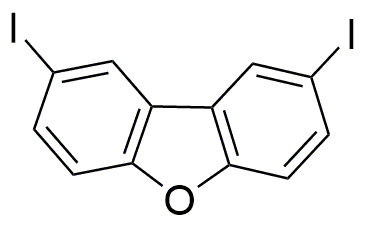2,8-Diiododibenzofuran is widely utilized in research focused on:
- Organic Electronics: This compound is used in the development of organic light-emitting diodes (OLEDs), enhancing the efficiency and color range of displays in consumer electronics.
- Pharmaceuticals: Its unique structure allows for the synthesis of potential drug candidates, particularly in targeting specific biological pathways, making it valuable in medicinal chemistry.
- Photovoltaics: The compound plays a role in creating organic solar cells, contributing to renewable energy solutions by improving light absorption and conversion efficiency.
- Material Science: It is utilized in the production of advanced materials with specific optical properties, beneficial for applications in sensors and imaging technologies.
- Research in Halogenated Compounds: The compound serves as a model for studying the effects of halogenation on chemical reactivity and stability, providing insights for chemists in various fields.
General Information
Properties
Safety and Regulations
Applications
2,8-Diiododibenzofuran is widely utilized in research focused on:
- Organic Electronics: This compound is used in the development of organic light-emitting diodes (OLEDs), enhancing the efficiency and color range of displays in consumer electronics.
- Pharmaceuticals: Its unique structure allows for the synthesis of potential drug candidates, particularly in targeting specific biological pathways, making it valuable in medicinal chemistry.
- Photovoltaics: The compound plays a role in creating organic solar cells, contributing to renewable energy solutions by improving light absorption and conversion efficiency.
- Material Science: It is utilized in the production of advanced materials with specific optical properties, beneficial for applications in sensors and imaging technologies.
- Research in Halogenated Compounds: The compound serves as a model for studying the effects of halogenation on chemical reactivity and stability, providing insights for chemists in various fields.
Documents
Safety Data Sheets (SDS)
The SDS provides comprehensive safety information on handling, storage, and disposal of the product.
Product Specification (PS)
The PS provides a comprehensive breakdown of the product’s properties, including chemical composition, physical state, purity, and storage requirements. It also details acceptable quality ranges and the product's intended applications.
Certificates of Analysis (COA)
Search for Certificates of Analysis (COA) by entering the products Lot Number. Lot and Batch Numbers can be found on a product’s label following the words ‘Lot’ or ‘Batch’.
*Catalog Number
*Lot Number
Certificates Of Origin (COO)
This COO confirms the country where the product was manufactured, and also details the materials and components used in it and whether it is derived from natural, synthetic, or other specific sources. This certificate may be required for customs, trade, and regulatory compliance.
*Catalog Number
*Lot Number
Safety Data Sheets (SDS)
The SDS provides comprehensive safety information on handling, storage, and disposal of the product.
DownloadProduct Specification (PS)
The PS provides a comprehensive breakdown of the product’s properties, including chemical composition, physical state, purity, and storage requirements. It also details acceptable quality ranges and the product's intended applications.
DownloadCertificates of Analysis (COA)
Search for Certificates of Analysis (COA) by entering the products Lot Number. Lot and Batch Numbers can be found on a product’s label following the words ‘Lot’ or ‘Batch’.
*Catalog Number
*Lot Number
Certificates Of Origin (COO)
This COO confirms the country where the product was manufactured, and also details the materials and components used in it and whether it is derived from natural, synthetic, or other specific sources. This certificate may be required for customs, trade, and regulatory compliance.


